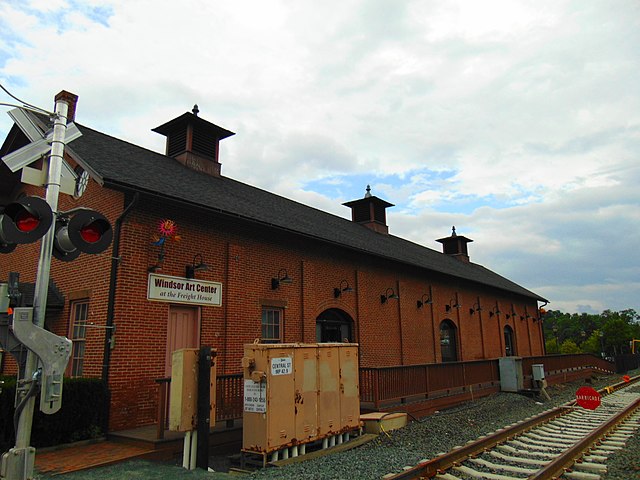Hartford and New Haven Railroad
The Hartford and New Haven Railroad (H&NH), chartered in 1833, was the first railroad built in the state of Connecticut and an important direct predecessor of the New York, New Haven and Hartford Railroad. The company was formed to connect the cities of New Haven, Connecticut, and Springfield, Massachusetts. It built northwards from New Haven, opening its first segment in 1838, and reaching Hartford in December 1839. The company reached Springfield in 1844 under the auspices of the Hartford and Springfield Railroad, a subsidiary chartered in Massachusetts. Branches were later built to Suffield, New Britain, and Middletown and operated by the Hartford and New Haven. The H&NH merged with the New York and New Haven Railroad in 1872, forming the New York, New Haven and Hartford Railroad.
Originally built by the Hartford and New Haven Railroad, the Windsor Freight House serves as the home of the Windsor Art Center today
The 1848 built Hartford and New Haven train station in Berlin, Connecticut. This station was replaced by a more modern building in 1893.
The Hartford Line began service in 2018
The Warehouse Point railroad bridge across the Connecticut River was completed by the H&NH in 1866. A rebuilt version of the bridge carries trains today.
New York, New Haven and Hartford Railroad
The New York, New Haven and Hartford Railroad, commonly known as The Consolidated, or simply as the New Haven, was a railroad that operated principally in the New England region of the United States from 1872 to December 31, 1968. Founded by the merger of the New York and New Haven and Hartford and New Haven railroads, the company had near-total dominance of railroad traffic in Southern New England for the first half of the 20th century.
A New Haven Railroad train in Bridgeport, Connecticut in 1962
Train over the Norwalk River (1914 postcard)
By 1900, the New Haven's trains could be found almost everywhere in Southern New England
NH logo created by Herbert Matter during the McGinnis era (1954–1956)








